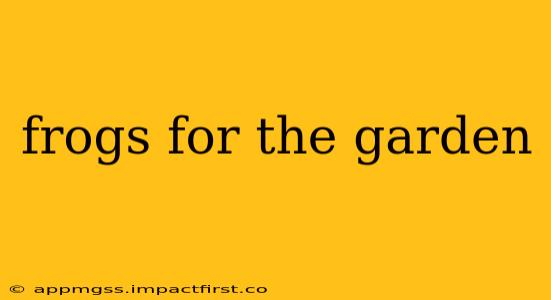Frogs are more than just charming creatures; they're valuable allies in the quest for a healthy, thriving garden. These amphibious friends provide natural pest control, enriching the ecosystem and adding a touch of wild beauty to your outdoor space. But attracting frogs requires understanding their needs and creating a welcoming habitat. This comprehensive guide will help you transform your garden into a froggy paradise.
Why Attract Frogs to Your Garden?
Before diving into the how-to, let's explore the numerous benefits of having frogs in your garden. These tiny titans of the insect world are highly effective pest controllers. Their diet consists mainly of insects, including slugs, snails, mosquitoes, and many other garden pests that can wreak havoc on your plants. By welcoming frogs, you reduce your reliance on harmful pesticides, promoting a more environmentally friendly and sustainable garden. Beyond pest control, frogs contribute to biodiversity, making your garden a more vibrant and complex ecosystem.
What kind of frogs are best for the garden?
This is a tricky question, as "best" is subjective and depends on your location. You aren't likely to introduce frogs to your garden; rather, you create a habitat that attracts local frog species naturally. The most effective frogs for pest control are typically those common in your region. Research the native frog species in your area and focus on creating a habitat that meets their specific needs. Remember, introducing non-native species can disrupt the local ecosystem, so always prioritize native frogs.
What do frogs need to thrive in a garden?
Creating a frog-friendly garden involves providing essential elements for their survival and well-being. These elements include:
A Water Source:
Frogs need a reliable source of water for drinking, breeding, and keeping their skin moist. This could be a pond, a bog garden, or even a large, shallow water bowl. Ensure the water is clean and free of chemicals. A slow-moving stream or a shallow pond with gently sloping edges allows for easy access and escape for frogs of all sizes.
Shelter:
Frogs need places to hide from predators and the sun. This can include rocks, logs, dense vegetation, and leaf litter. Providing ample cover creates a sense of security, encouraging frogs to stay and thrive.
Food Source:
While you don't need to actively feed frogs, a healthy insect population is crucial. Avoid using pesticides that could harm both frogs and their food sources. Maintaining a diverse, insect-rich environment will naturally attract frogs and ensure their survival.
Protection from Predators:
Cats, birds, and snakes are all potential predators of frogs. Providing adequate cover and a safe haven within your garden can significantly reduce the risk of predation.
How to create a frog-friendly garden?
Transforming your garden into a frog paradise requires a combination of thoughtful planning and natural elements. Here are a few tips to get you started:
- Create a pond: A pond, even a small one, is the cornerstone of a frog-friendly garden. Choose a location that receives some sunlight but also provides shade during the hottest part of the day. Ensure the edges are gently sloping to prevent frogs from getting trapped.
- Plant native vegetation: Native plants provide food and shelter for insects, which in turn attract frogs. They also help maintain the overall health of your garden ecosystem.
- Avoid pesticides: Pesticides are harmful to frogs and their food sources. Opt for organic gardening methods to protect both frogs and your plants.
- Add rocks and logs: These provide shelter and basking spots for frogs.
- Maintain a natural environment: Avoid overly manicured lawns. Leave some areas slightly wild to provide cover and habitat for insects and frogs.
What plants attract frogs?
Many plants indirectly attract frogs by providing habitat for insects or offering shade and moisture. Native plants are generally best, as they support the local ecosystem. Some examples might include:
- Water plants: Water lilies, pickerel weed, and other aquatic plants offer shelter and breeding sites for frogs.
- Shade-providing plants: Trees and shrubs provide shade and protection from predators.
- Groundcover plants: Plants like ferns and wildflowers create a moist, sheltered habitat for insects and frogs.
Remember to research the best plants for your specific region and climate.
What are some common frog problems in the garden?
While frogs are beneficial, some issues might arise. These include:
- Lack of water: Ensure your pond or water source remains consistently filled, especially during dry periods.
- Predators: Consider ways to discourage cats and other predators from entering your garden.
- Disease: Monitor your frog population for signs of illness. If you notice sick or dying frogs, consult a wildlife specialist.
- Pesticides: Always avoid using pesticides to avoid harming your frogs and their food source.
By implementing these strategies and understanding the needs of your local frog population, you can create a thriving ecosystem in your garden, benefiting both you and these amazing amphibians. Remember that patience is key; attracting frogs takes time and consistent effort in providing a welcoming and suitable habitat.
